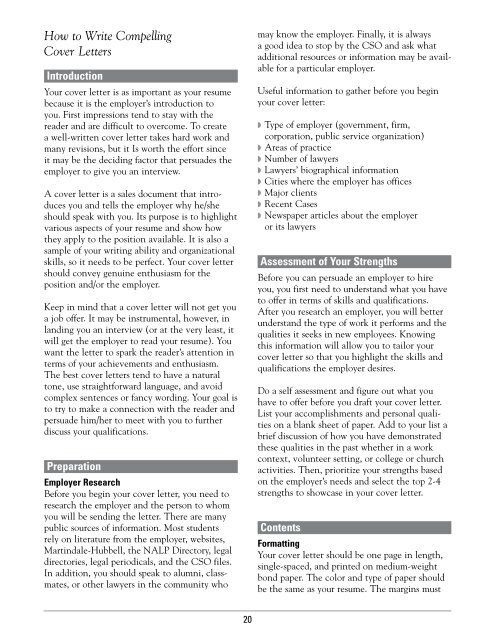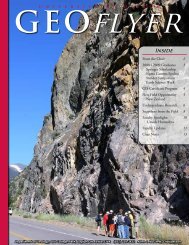UDSL Job Search Manual - University of Dayton
UDSL Job Search Manual - University of Dayton
UDSL Job Search Manual - University of Dayton
Create successful ePaper yourself
Turn your PDF publications into a flip-book with our unique Google optimized e-Paper software.
How to Write Compelling<br />
Cover Letters<br />
Introduction<br />
Your cover letter is as important as your resume<br />
because it is the employer’s introduction to<br />
you. First impressions tend to stay with the<br />
reader and are difficult to overcome. To create<br />
a well-written cover letter takes hard work and<br />
many revisions, but it Is worth the effort since<br />
it may be the deciding factor that persuades the<br />
employer to give you an interview.<br />
A cover letter is a sales document that introduces<br />
you and tells the employer why he/she<br />
should speak with you. Its purpose is to highlight<br />
various aspects <strong>of</strong> your resume and show how<br />
they apply to the position available. It is also a<br />
sample <strong>of</strong> your writing ability and organizational<br />
skills, so it needs to be perfect. Your cover letter<br />
should convey genuine enthusiasm for the<br />
position and/or the employer.<br />
Keep in mind that a cover letter will not get you<br />
a job <strong>of</strong>fer. It may be instrumental, however, in<br />
landing you an interview (or at the very least, it<br />
will get the employer to read your resume). You<br />
want the letter to spark the reader’s attention in<br />
terms <strong>of</strong> your achievements and enthusiasm.<br />
The best cover letters tend to have a natural<br />
tone, use straightforward language, and avoid<br />
complex sentences or fancy wording. Your goal is<br />
to try to make a connection with the reader and<br />
persuade him/her to meet with you to further<br />
discuss your qualifications.<br />
Preparation<br />
Employer Research<br />
Before you begin your cover letter, you need to<br />
research the employer and the person to whom<br />
you will be sending the letter. There are many<br />
public sources <strong>of</strong> information. Most students<br />
rely on literature from the employer, websites,<br />
Martindale-Hubbell, the NALP Directory, legal<br />
directories, legal periodicals, and the CSO files.<br />
In addition, you should speak to alumni, classmates,<br />
or other lawyers in the community who<br />
may know the employer. Finally, it is always<br />
a good idea to stop by the CSO and ask what<br />
additional resources or information may be available<br />
for a particular employer.<br />
Useful information to gather before you begin<br />
your cover letter:<br />
◗ Type <strong>of</strong> employer (government, firm,<br />
corporation, public service organization)<br />
◗ Areas <strong>of</strong> practice<br />
◗ Number <strong>of</strong> lawyers<br />
◗ Lawyers’ biographical information<br />
◗ Cities where the employer has <strong>of</strong>fices<br />
◗ Major clients<br />
◗ Recent Cases<br />
◗ Newspaper articles about the employer<br />
or its lawyers<br />
Assessment <strong>of</strong> Your Strengths<br />
Before you can persuade an employer to hire<br />
you, you first need to understand what you have<br />
to <strong>of</strong>fer in terms <strong>of</strong> skills and qualifications.<br />
After you research an employer, you will better<br />
understand the type <strong>of</strong> work it performs and the<br />
qualities it seeks in new employees. Knowing<br />
this information will allow you to tailor your<br />
cover letter so that you highlight the skills and<br />
qualifications the employer desires.<br />
Do a self assessment and figure out what you<br />
have to <strong>of</strong>fer before you draft your cover letter.<br />
List your accomplishments and personal qualities<br />
on a blank sheet <strong>of</strong> paper. Add to your list a<br />
brief discussion <strong>of</strong> how you have demonstrated<br />
these qualities in the past whether in a work<br />
context, volunteer setting, or college or church<br />
activities. Then, prioritize your strengths based<br />
on the employer’s needs and select the top 2-4<br />
strengths to showcase in your cover letter.<br />
Contents<br />
Formatting<br />
Your cover letter should be one page in length,<br />
single-spaced, and printed on medium-weight<br />
bond paper. The color and type <strong>of</strong> paper should<br />
be the same as your resume. The margins must<br />
20

















